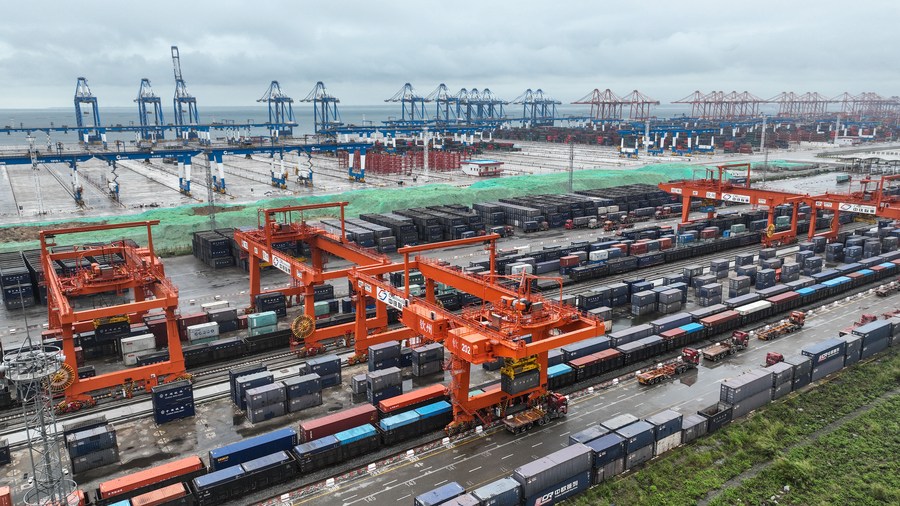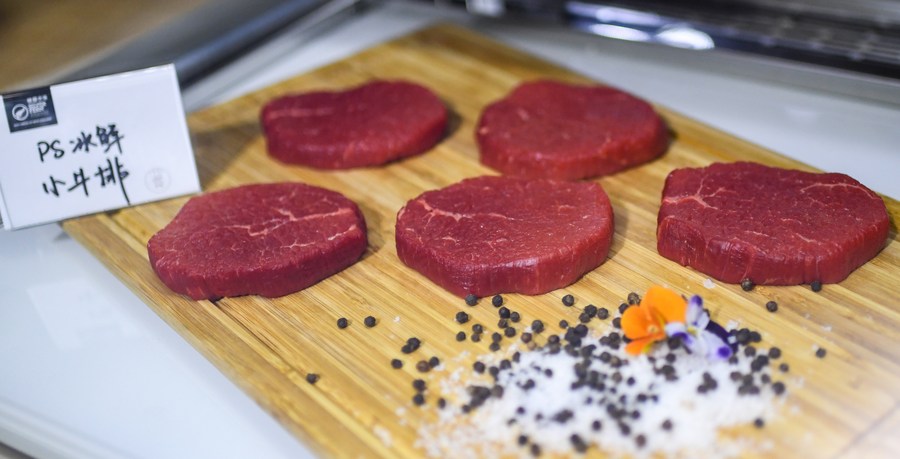
This aerial photo taken on May 11, 2023 shows an automatic container terminal of Qinzhou Port and a railway container distribution center in Qinzhou City, south China's Guangxi Zhuang Autonomous Region. (Xinhua/Zhang Ailin)
NANNING, Aug. 2 (Xinhua) -- A container ship carrying Brazilian beef has recently arrived at China's Qinzhou Port in the Beibu Gulf after more than a month's voyage from the port of Santos in Brazil.
After being unloaded, the goods were further transported to the populous Pearl River Delta region in south China and provinces of Yunnan, Guizhou, and Sichuan in southwest China, before being served at restaurants or cooked by local households.
China is a major consumer of beef. In recent years, its import volume of beef has continued to rise, showing a rapid growth momentum.
According to customs data, China's beef imports have more than doubled from 1.04 million tonnes in 2018 to 2.69 million tonnes recorded last year. Last year alone, China imported nearly 17.76 billion U.S. dollars of beef, an increase of 42.19 percent over the previous year.
In the first half of the year, China's imported beef and edible cow entrails reached 1.25 million tonnes, marking a cumulative increase of 6.3 percent, year on year. China mainly imports beef from countries including Brazil, Argentina, and Uruguay.
Guangxi Free Trade Zone Linhai Supply Chain Co., Ltd., located in the Qinzhou Port of Guangxi Zhuang Autonomous Region, started its business by dealing with red wine imports. Driven by market demand, it began to take over the cold-chain import business in recent years.
The company now cooperates with JBS S.A, a Brazilian meat processing company, to import Brazilian beef.
In 2022, China's beef imports from Brazil totaled 7.5 billion U.S. dollars, accounting for 42.38 percent of China's total beef imports.
Qin Shide, deputy general manager of Guangxi Free Trade Zone Linhai Supply Chain Co., Ltd., said that last year, they imported 17 beef containers weighing 475 tonnes, all from Brazil.
As the economy and consumption gradually recover, the company plans to buy more beef from Brazil this year, and the import value is expected to quadruple that of last year, Qin added.

Photo taken on Nov. 7, 2020 shows pieces of refrigerated steak at the Food and Agricultural Products exhibition area during the third China International Import Expo (CIIE) in Shanghai, east China. (Xinhua/Chen Yehua)
Rice or noodles with beef toppings in street parlors are among the most sought-after in China. Beef is a common bestseller in barbecue and hotpot restaurants, and consumers favor steak sets in all kinds of Western cuisine eateries.
Zhou Yu, a resident in Guangxi's Nanning, said steaks served with a plate of pasta and broccoli are now a common main dish for her family's supper, adding that recently, imported beef is much cheaper than before, allowing her family to consume beef more frequently.
China's well-developed e-commerce has also fueled the beef import boom. Livestream shows have brought various high-quality imported beef onto the dining tables of Chinese families.
On the video-sharing app Douyin, the Chinese version of TikTok, consumers are willing to fork out for premium steak imports via the live stream shows.
Many affordable steak sets can be ordered online with a few clicks on the phone screens, and then mailed to the consumers' doorsteps without any extra delivery fees, thanks to the country's efficient cold-chain logistics.
Industry insiders believe that with the economic recovery, the catering sector is gradually picking up, and China's beef consumption will continue its growth in 2023. ■












